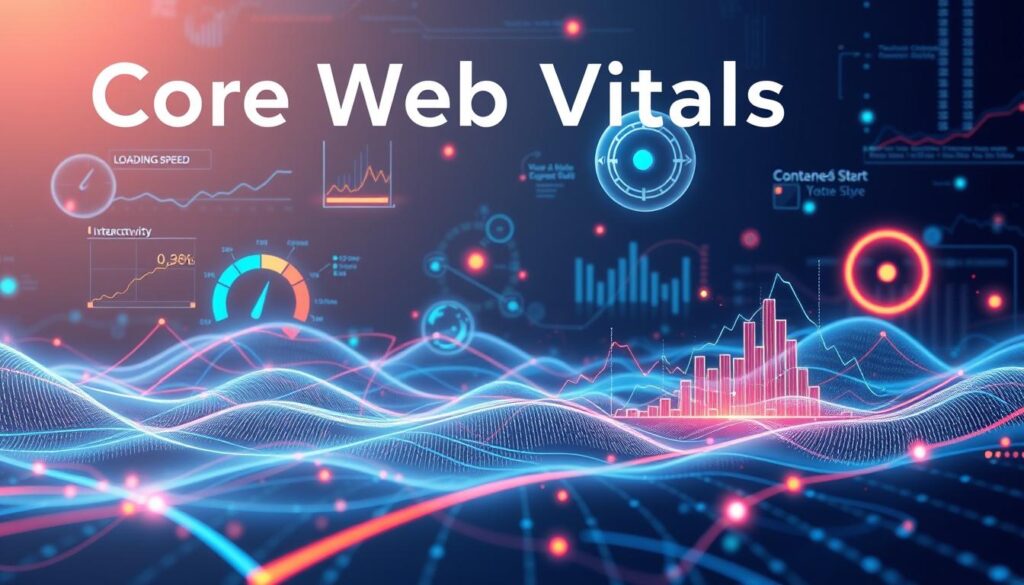“The best place to hide a dead body is in page two of Google.” It’s a morbid thought (and hopefully a joke!) but it points out the hard truth. In today’s digital landscape visibility is king. And in 2025, Core Web Vitals are more crucial than ever to securing that coveted top spot on search engine results pages (SERPs).
But what exactly are Core Web Vitals? Why should you care? But how can you improve these crucial metrics of your website?
This ultimate guide dives deep into the world of Core Web Vitals, providing actionable insights and strategies to help you conquer the SERPs and provide an exceptional user experience. Let’s get started!
What are Core Web Vitals?
Simply put, Core Web Vitals are a set of metrics that measure how users experience the speed, responsiveness, and visual stability of a web page. They are the measurement of UX by Google. And, these are the metrics that help figure out what your website visitors ‘visually’ notice, something that will have a direct impact on their first impression about your website.

Why are Core Web Vitals important in 2025?
User experience has increasingly been the parameter of emphasis by Google in ranking. And Core Web Vitals are a major part of that equation. And in fact, now they are a confirmed ranking signal. If your website does poorly on these metrics, it could be hurting your search rankings.
But it’s not just about SEO. Core Web Vitals directly correlate with user satisfaction. The slower the website, the slower the pace, the higher the bounce rates, worse engagement and less conversions, you get the idea. 2025 is a highly competitive online world, and a stellar user experience is pretty much non negotiable.
The 3 Core Web Vitals
There are three primary Core Web Vitals you need to focus on:
- Largest Contentful Paint (LCP): This one checks how long it takes for the biggest content element on the page to load. Put another way then, this is the perceived load speed: how quickly do users see your page is actually there.
- First Input Delay (FID): The responsiveness of a page is quantified by FID. It refers to the time a user first interacts with a page (e.g., clicks a link or button) to the time the browser can react to that interaction.
- Cumulative Layout Shift (CLS): When reading an article online, have you ever had the text jump around as more elements load at the same time? That’s a layout shift and it’s the worst! The total amount of unexpected layout shifts happening on a page over its entire lifetime is measured by CLS.
Deep Dive into Each Core Web Vital
So, let’s roll up our sleeves and go through each Core Web Vital, explaining why they matter and how you can optimize for them now.

Largest Contentful Paint (LCP)
What is LCP?
Perceived load speed is what LCP is about. It measures render time of a largest image or text block within the viewport to render. The faster your LCP, the quicker users realize your page is loading (and, typically, it’ll mean that people will spend more time engaging with your page).
Why LCP Matters
A slow LCP can lead to:
- Higher bounce rates: Users are impatient! That means if your page isn’t loading fast enough they are very very likely to abandon your page and go to one of your competitors to complete the task.
- Lower engagement: An LCP that is pretty slow can really cripple your site’s usability and thus give a bad user experience.
- Reduced conversions: If users are not happy with how fast your website loads, chances are they won’t do the things you want them to do on your website like buy or fill out a form.
Optimal LCP Score
An LCP of 2.5 seconds or slower can provide a great user experience, but sites should aim to be even faster. All of these tools let you measure your LCP.
Actionable Tips to Improve LCP
- Optimize Images:
- Compress images: Reduce image file size on your site but without a worry of compromising the quality by using tools like TinyPNG or ShortPixel.
- Use modern image formats: PNG or JPEG are often better compressed by WebP.
- Implement lazy loading: Load images only when they become visible in the viewport, and defer loading off screen images until they are needed. By reducing the size of request resources, this can significantly increase the initial load time.
- Compress images: Reduce image file size on your site but without a worry of compromising the quality by using tools like TinyPNG or ShortPixel.
- Leverage a Content Delivery Network (CDN): With a CDN, your website’s assets are shipped across the world on servers, distributing the load so that users get content from a server closer to their location. This also helps reducing latency and you will notice improved load times.
- Cache Assets Efficiently: Caching is done by browsers to store static assets (for e.g., images, css, and javascript files) locally, so as not to get downloaded every time a user visits your page.
- Minimize Render-Blocking Resources: CSS and JavaScript files, for instance, are able to block the rendering of your page. Minimize these by:
- Deferring non-critical JavaScript: Only load that JavaScript which is essential for initial render, and delay everything else until the page has loaded.
- Inlining critical CSS: Include the CSS that’s necessary for the above the fold content within the HTML and get rid of the extra request.
- Deferring non-critical JavaScript: Only load that JavaScript which is essential for initial render, and delay everything else until the page has loaded.
- Improve Server Response Times: A slow server can really add to LCP. Remember to optimise server configuration, your database queries and backend code to react to requests in the fastest way possible.

First Input Delay (FID)
What is FID?
FID is a measure of a page’s interactivity. In other words, it means that time it takes for the browser to process a user’s interaction with an element, such as clicking a button or tapping on a link. A low FID will tell you that your page is responsive and feels snappy to users.
Why FID Matters
A high FID can lead to:
- Frustrated users: If a page feels unresponsive at all, users will assume it is broken or their action didn’t register.
- Increased bounce rates: If a website feels and is slow and unresponsive, users are more prone to go away.
- Decreased conversions: Users who find your page hard to interact with are less likely to make the desired actions.
Optimal FID Score
To have a good user experience your FID should be less than that of 100 milliseconds. Just as with LCP, the same tools mentioned above can be used to measure FID.
Actionable Tips to Improve FID
- Minimize JavaScript Execution Time: FID can be effected a lot by large JavaScript files.
- Reduce the size of your JavaScript files: Minimize your JavaScript code and compress it.
- Remove unused JavaScript: Audit your code, look out for any script you don’t need and delete them.
- Break Up Long Tasks: The page is unresponsive because long running JavaScript tasks are blocking the main thread. However these tasks are expensive, you can break them up into smaller chunks so that the browser is able to respond to user input more quickly.
- Optimize Third-Party Scripts: Third party script sources (such as analytics trackers and social media widgets) can have a big influence on FID.
- Load third-party scripts asynchronously: This lets the browser continue parsing the page until it fetches the script, so you don’t have to worry about blocking the entire render of the page.
- Consider using a tag manager: With a tag manager, you can control and optimize your third party scripts.
- Load third-party scripts asynchronously: This lets the browser continue parsing the page until it fetches the script, so you don’t have to worry about blocking the entire render of the page.
- Use a Web Worker: Web workers allow you to have JavaScript running in the background and leave the main thread for interacting with users.

Cumulative Layout Shift (CLS)
What is CLS?
Visual stability of a page is measured by CLS. This is quantified as the amount that elements shift around, unexpectedly, when the page loads. It’s a measure of how ‘jumpy’ your page is.
Why CLS Matters
A high CLS can lead to:
- Poor user experience: Layout shifts that are not expected by the user, and not visually executed in a meaningful way, are frustrating to the user, as they can be disorienting.
- Accidental clicks: If it changes position suddenly, then a user may have accidentally clicked on the wrong element.
- Reduced accessibility: For users with disabilities, it’s hard for them to interact with your website when layout shifts occur.
Optimal CLS Score
Try and achieve a CLS score of less than 0.1. Once again you can check your CLS using tools like PageSpeed Insights, Lighthouse, or Chrome DevTools.
Actionable Tips to Improve CLS
- Reserve Space for Images and Ads: Include width and height attributes on images, or use CSS aspect ratio boxes to reserve space for the images, so they’re not displayed differently in different browsers. Because when the image loads it isn’t pushing the content below out of the way. The second is to do the same for ad slots to avoid surprises.
- Avoid Inserting Content Above Existing Content: Don’t insert right content dynamically above other content, unless it’s in response to user interaction. It can mess up the page reflow and thus induce the generation of layout shifts.
- Use Predictable Animations and Transitions: Using animations or transitions, they make sure it’s smooth and predictable. Avoid animations which change the layout of the page.

Core Web Vitals and SEO
How Core Web Vitals Impact Search Rankings
As we mentioned earlier, we already know that Core Web Vitals are an official Google ranking factor. This also means that websites that do well with their Core Web Vitals will be more favorably ranked in search results.
Mobile-First Indexing
For the most part, Google indexes and ranks mostly the mobile version of your website. Therefore, it’s crucial to optimize your website’s Core Web Vitals for mobile devices. Use responsive design and mobile friendly techniques to achieve a perfect mobile experience.
The Future of Core Web Vitals in SEO
Google’s algorithms are continually researched and developed and fewer and fewer importance is put to the mechanics of search. It’s likely that Core Web Vitals will play an even more significant role in SEO in the future. Stay informed about updates and trends in Core Web Vitals to maintain a competitive edge.
Tools and Resources
Here are some essential tools and resources to help you measure and improve your Core Web Vitals:
- PageSpeed Insights: This tool gives you a full analysis of your site performance, your Core Web Vitals scores and how you can improve them.
- Lighthouse: A free, open source tool that lets you audit your website’s performance, accessibility, best and most SEO practices. It’s a Node module, and you can run it from Chrome DevTools, or run it directly via the command line.
- Chrome DevTools: Built in to the web browser, it’s a set of Chrome developer tools. In the “Performance” tab, You are shown detailed loading performance instructions of your website.
- Search Console (Core Web Vitals report): In Data in Action, we also mention a dedicated Core Web Vitals report in Google Search Console where you can see the real world performance of your pages as data from real users.
- Web.dev: Articles, guides and tools for web development best practice – in this comprehensive resource from Google – reading on Core Web Vitals and more.
- Google’s Core Web Vitals documentation: Next, we share the details about Core Web Vitals as it was made available in Google’s Documentation.
Case Study: How One of our client improved conversions 20% by optimizing Core Web Vitals
The e-commerce store we have as a client had high bounce rates and low conversion rates. We analyzed their website through PageSpeed Insights and saw that their Core Web Vitals weren’t great, especially their LCP.
We then implemented the following optimizations:
- Optimized images: Images were compressed and we lazy loaded them.
- Improved server response times: The cloud was uncomfortable for me, so we upgraded their hosting plan and tuned their database queries.
- Minimized render-blocking resources: We skipped non essential JavaScript and included critical CSS as inline.
Consequently, they were able to improve their Core Web Vitals scores significantly because of these optimizations. This helped us improve their LCP by 40% and reduce their bounce rate by 15%. Most important of all, their conversion rate increased 20% !
This case study shows how Core Web Vitals can improve the real world. Through user experience, our client achieved great business results.
Conclusion
In 2025’s competitive digital landscape, Core Web Vitals are no longer optional. If you want to have a great user experience, they’re a must. So, if you find out these metrics and implement the strategies given in this guide, you’ll be able to make your website fast, responsive, and visually stable that results in more traffic, engagement, and conversions.
Optimize your website for Core Web Vitals today and see your online presence grow.
FAQs
What are Core Web Vitals?
Google defines Core Web Vitals as web performance metrics. Measurement of how good a website works for a user. These are the main three, namely Largest Contentful Paint (LCP), First Input Delay (FID), Cumulative Layout Shift (CLS).
Why are Core Web Vitals important for my website?
Google uses Core Web Vitals to rank websites, that’s why they matter. Those sites that perform well on these keymetrics get more views. More people have the opportunity to visit your site.
How can I measure and monitor my website’s Core Web Vitals?
There are tools such as Google Search Console and Chrome User Experience Report by which you can do such calculations. PageSpeed Insights and Lighthouse are also tools, for example.
What are the recommended benchmarks for good Core Web Vitals scores?
Google suggests: It’s good if LCP is lower than 2.5 seconds, FID is less than 100 milliseconds and CLS is below 0.1.
How can I optimize my website to improve Core Web Vitals?
Optimizing images and media will improve your site. Responders are also looking at server response time and layout shifts. Make your site more fun.
How do Core Web Vitals differ from traditional web performance metrics?
The user experience is what Core Web Vitals are focused on. They test how quickly your content loads, how responsive your site is and how stable your layout is.
How often do Core Web Vitals get updated?
As technology develops and technologies change, Google updates Core Web Vitals. Follow these updates and keep your site in a good shape.
Can Core Web Vitals be optimized for both mobile and desktop devices?
Yes, if there’s not, optimize for both mobile and desktop. Google looks at the performance on all devices. The key here is to focus on giving a great experience on all devices.
What are some common mistakes to avoid when optimizing for Core Web Vitals?
Don’t neglect Core Web Vitals, don’t be fixated on one metric, and don’t forget to A/B test your changes. Don’t just forget the most important optimizations.
How can I future-proof my website’s performance for upcoming changes to Core Web Vitals?
Stay updated on the updates to Core Web Vitals. Use best practices, proactively. Look at new technologies to have the best possible experience to ensure visitors have a lively and speedy experience on your site.

